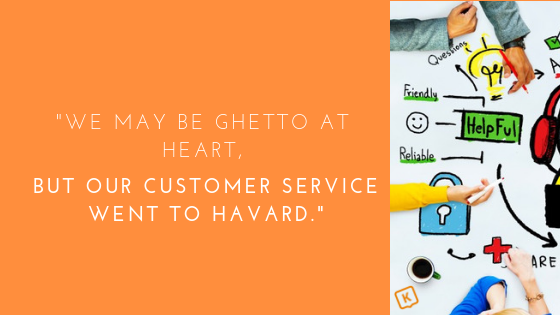Before anything else, I want to state right out of the door that these findings are observations I have personally made over time and found useful to my role as a customer service agent in the Ecommerce industry. I don’t have statistics or hard evidence, they’re simply learnings from my experience which were somewhat confirmed through a couple of Customer Service courses I took on Alison. With this being said, let’s get right to it :)
Internal Service / Internalising Customer Service
The main deal of customer service is to make a client feel needed, appreciated and happy. We want them to trust our word when we say our product will work and if it doesn’t, we won’t abandon them but find alternatives to make it work. Behind us in this vision is the force of the entire company which ensures that our word is kept. The crucial role of customer service usually falls between the rock and the hard place of relating with clients as well as various departments in our company. This requires a good balance of both external and internal customer service relations. In order to meet the main responsibility of satisfying our clients, it is very relevant that we cultivate and maintain successful relationships within our company, especially with regards to departments whose work directly affect clients. An Elaine Allison article noted that, a breakdown in our internal customer service eventually affects our external customer service and this in turn, takes a toll on retaining and attracting customers. I personally find that when I am in a good place with regards to my relationships with my colleagues, the customer service process is smoother. However, It’s a completely different atmosphere after a scuffle over snacks with Danny in Finance. It pays to be friendly, encouraging, and of service to our colleagues as they are inspired to go the extra mile for us when we need them in our work of serving customers. Also, appreciating their efforts and thanking them for their assistance is a demonstration that they’re not just doing their job, but they’re doing it well.
It is good to communicate the urgency of a client’s needs to whoever can resolve them without undue pressure as this may come across as badgering. After all, if we’re uncomfortable under fire from customers, it’s reasonable to not transfer the heat to others. Another relevant aspect of internal service is to avoid placing blame on others. This includes blaming other departments externally, through customer correspondence and using the language of blame internally. The end goal of everyone is to ensure that the company is working fluidly; missteps are rarely intentional and shifting blame is usually unhealthy and insensitive.

Instant Service: Alerts and FAQs
Customer service can also take place in our absence. In fact, it is great customer service if clients can easily have their questions answered instantly, and with little help from us. Anticipating the questions of customers before they ask them is a sure way of catering to their needs in minimum time. An FAQ section which contains topics curated from studying the trends of the most frequently reported issues is an amazing tool for clients as they only need to scan through or use a basic search method to find answers. This cuts off the wait time for responding via email.
Another important factor of instant customer service is to be as informative as possible with regards to ongoing activities and changes in product. If a customer reports an issue and after tests it is discovered that this inconsistency persists, it is good practice to inform other users of this issue. However, I have learnt from experience that an email blast to all clients might not be the best way to handle this information as it only goes to alarm clients who may not be aware of the problem. It also paints a negative picture of the product if there are one too many alerts. Instead, there could be a small pop-up notification closest to the heart of the issue so only users interested in the specific feature are made aware. It would also be great to provide a timeline for the resolution of the issue so users know when to check back. By taking the initiative of informing clients of an issue, you curb their anxiety and possible distrust if they find that something is not working and also save yourself the possible flood of emails from clients encountering the same issues.

Keep it professionally personal
We’ve all had that cab driver who got too ‘friendly’ with questions when all we wanted was to be left alone or received that fourth email from some support person asking us for more time to resolve our problems. Both situations are extremely irritating at best and frustrating at worst.
It’s a good thing to create a perfectly balanced situation of giving enough information or follow-up. To do this, it is important to know our clients as actual people. When you realise that a client keeps asking for updates by the hour, it should indicate to you that, perhaps this person needs constant reassurance and clarification and wants to be a part of the resolution; include the said client in the problem solving process by frequently updating them and requesting their help for minor tests like using a different browser, clearing their cache, trying a different URL, etc. It is even more thrilling if the client arrives at the resolution during one of these tests.
There are also clients who just want it fixed. They don’t have the time to stop and chat nor do they want to hear about what the issue is. With these, it’s a bit tricky, as you would want to ensure they are updated, but also make sure that they do not feel irritated. Use your discretion on how to update them. A good tip would be to speak in a matter-of-fact language and keep updates brief.
When it comes to that issue which proves a chore and the Estimated Time of Arrival/Completion (ETA) communicated to clients is looming ahead, it is best to alert clients that this issue might take more time. Already, you should ensure that at the first instance of giving an ETA, you double the duration communicated to you by whichever internal service is responsible for handling that issue in order to have a loose ETA. If the issue gets resolved before then, your company comes across as very efficient. If it comes in on time, you are perceived as time conscious. But if it comes after, without a prior warning of delay, then you’re simply unprofessional. If you need to ask for an extension a second time, it is good to make it as personal as possible as by now, clients might have been waiting too long. If you were communicating by email, this is a good time to call and apologize for the delay then ask for an extension. It demonstrates the equal sadness of your company about the delay and that you are not just moseying on the job; you really want their issue fixed.

“All the World is a Backstage”
Contrary to Shakespeare's famous quote, for customer service agents, the world outside work is not a stage, but a backstage where we can learn the lines of our work, make mistakes, develop skill or refine them, and get away with it. As customer service agents, we have the lucky insight of wearing the shoes of our clients as we are also clients to other agents. Customer service is inescapable as we interact with all forms of it in our daily lives. It is crucial to take note of service which sets your mind at ease and makes you smile even when your issue has not been resolved. This is the kind of service you want to replicate in your support role. You may have also had some downright nasty service. While the pressure and stress which sometimes come with attending to the needs of diverse people on a daily basis may create a sense of empathy, you will also fully understand the frustration and helplessness of clients when the one person supposed to hold their hand in solving an issue is unkind and unhelpful. From all of the rich experiences around us, it is good to take note of each action or gesture and include it in our practice in order to perfect it.
In closing, dealing with people is concurrently the hardest and easiest thing in the world. It is easy because we are also human beings with emotions, and it is hard because every human being is different. But once we are certain of the value of our product or service and believe in the objectives of our company, we only need to make our clients feel at home on our app, and we can be guaranteed that they will not only stay, but will recommend to others.









